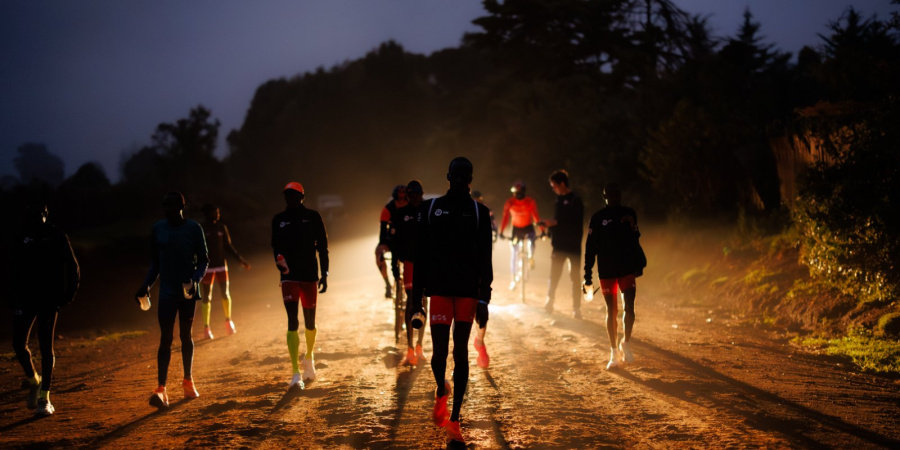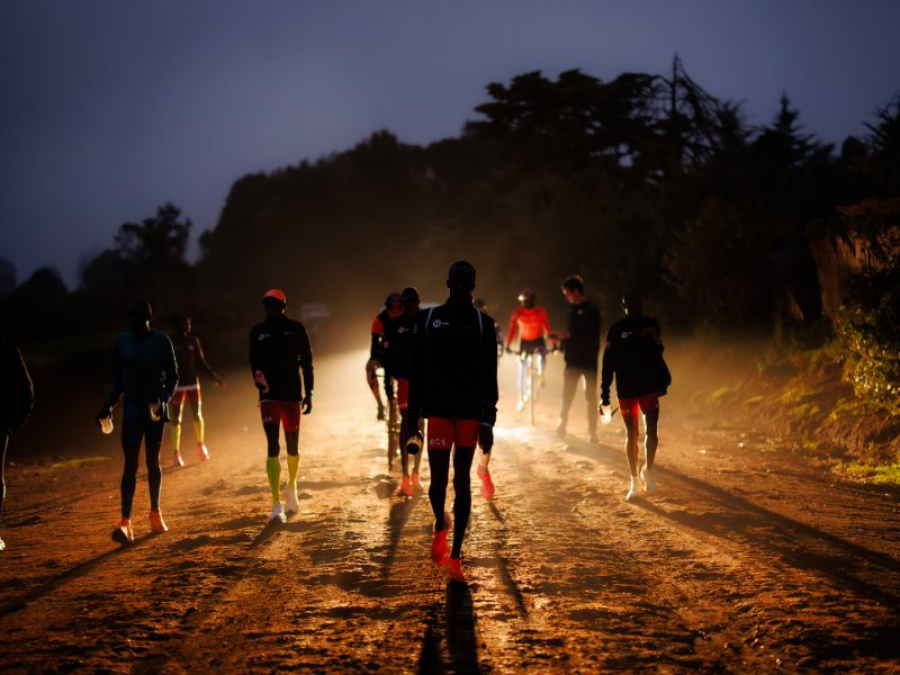

Where We Train: Kaptagat, Kenya
Six days a week, 25 athletes wake up at Global Sports Communication's camp in Kaptagat, Kenya, ready for another day moulding themselves into the world's very best.
The same alarm goes, whether you are an 800m star or an upcoming marathoner. Between 5 and 6 every day, all year round. The day’s first small lesson is the importance of discipline.
As the athletes ready themselves, the alarms are echoed by the distant or closer moos of the local cattle, often seen slowly ambling round the 400m track adjacent to the sleeping compounds. Waking birds throw their voices into a calming mix.
Invariably in darkness, a rising sun slowly starts to illuminate a vibrant rich red sky.
The reason for the early start is simple. Whilst Kaptagat’s position close to the Equator means a relatively constant predictable climate, mornings are generally the better time to train. Cooler, without the heat of a day’s sunshine, generally thunder and rain appear later in the day, if either do come.
So in their compound, athletes, the overwhelming majority sharing a room with one other, will head to the toilet, put on a few layers and slowly amble to the gates, 100m or so down a tree-lined lane. Almost always unintentionally fasted.
Then the day’s training will start. Each day will have a different rhythm, Mondays are most likely a medium-length relatively easy run. Well as easy as can be when you are at 2700m altitude, rolling round undulating hills. The same will be repeated on Wednesdays and Fridays.
Head right out the gates and they roll up to the Kaptagat forest, a tranquil sea of tall trees, interspersed with natural ponds and soft, forgiving clay underfoot. Ideal for giving some respite to legs well-versed in 210km per week.
Look closely and you will even see new saplings being planted in association with the Eliud Kipchoge Foundation and Greening Kaptagat programme. The double Olympic champion is passionate about how these paths and the rich clean air that surrounds them have revitalised him on the pursuit of many a challenge on the edge of the possible.
Head left and it is often a tarmacked road, not ideal but sometimes necessary when bad weather challenges the footing of their favourite routes. A rolled ankle simply isn’t worth it.
Each time they head out, they will do so in silence, focused on the task at hand, the only communication often a hand signal to alert others of a fallen branch or pothole in the road. The rhythmic sound of their footsteps breaking the quiet.
Track Tuesdays
Tuesdays, Thursdays and Saturdays are different. The first of these will often see them head to a local track, all boarding minibuses and getting off still in darkness, some of the first to arrive.
Here they will meet Patrick Sang and his team, receiving for the first time the prescribed session from assistant coaches Richard Metto, Brimin Kipruto or Enoch Koech. Little time to digest what is to come, within minutes they are warming up, doing drills together.
What seems like a few moments later, there they stand at the 200m or start line, one long train often with each member emblazoned with the Nike NN Running Team kit. Their only mark of difference being whatever model of trainer they have chosen to wear that day.
For around an hour they complete from 15 to 20km in intense but restrained volume, no athlete pushing himself beyond the limit but each taking their turn to marshal the ship.
A few fistbumps, some laps of the track to cool down and back into the minibuses they go. Every movement with purpose, little wasted.
The majority take this route. There are of course exceptions. The middle-distance stars will often train a little later, to allow Sang to monitor both groups with the appropriate attention. These athletes will have a small breakfast before, a banana often a useful accompaniment.
Here the likes of double world-record-holder Faith Kipyegon and steeplechase star Faith Cherotich will warm up alongside double Commonwealth Games 800m champion Wycliffe Kinyamal, the whole group conducting a much lengthier routine than their marathon teammates before.
A big focus on preparing the legs for the explosive movements that follow, the group will follow with rhythm the tone set by Kipyegon, almost studying their teammate as a model for success at the highest level.
Then the session will begin, the same purpose we have seen before but often less volume at a higher intensity. A few laps of the track to cool down and the stadium returns to quiet once more.
The long run
Thursdays, even for the 800m runners are often one of the most important days of the week – long run day. Here the athletes will gather outside the gates, awaiting Sang’s instructions. Then they will be sent off in intervals, the slower runners receiving a small headstart from the elites who know this session is the key to their chances of marathon major success.
Often 40km, the most famous of these routes, the “Boston” loop sees them snake their way up the escarpment, finishing over 500m of elevation almost overlooking the Great Rift Valley beneath them.
Sang will ride by in a pickup truck with simple instructions to his athletes, press on or step back from the throttle. Some days are not the ones to push.
Maurten drinks will be handed over in intervals, passed round the group. Often one guy without breaking stride picking up a couple for the team to share. A few sips and they will be returned, attention to the road once more.
Eventually it will be over, even if for some athletes, they always seem to give the impression they want to head on longer.
Fartlek day
Try and follow the Saturday fartlek and you may struggle as the group speeds up and slows down, the group stretching and contracting like a giant centipede gliding over the Kaptagat clay.
A format that helps so much with the demands of tactical racing, the fartlek are repetitions of fast sections followed by slower ones, over changing rolling terrain. For example Sang may set an hour of three minutes fast, one minute slow over an undulating course.
One fast section may see half-marathon star Daniel Mateiko glide up a hill hard, recovering for a minute on the top and find his next interval a mad dash down.
Different muscles tested and mental limits strained in a stop-start hour that is the closest to a game you can find when also pushing at the boundaries of your own running potential.
When it does eventually stop, however, the reward is great, one day at home before they return on Monday.
The cycle continues.






















